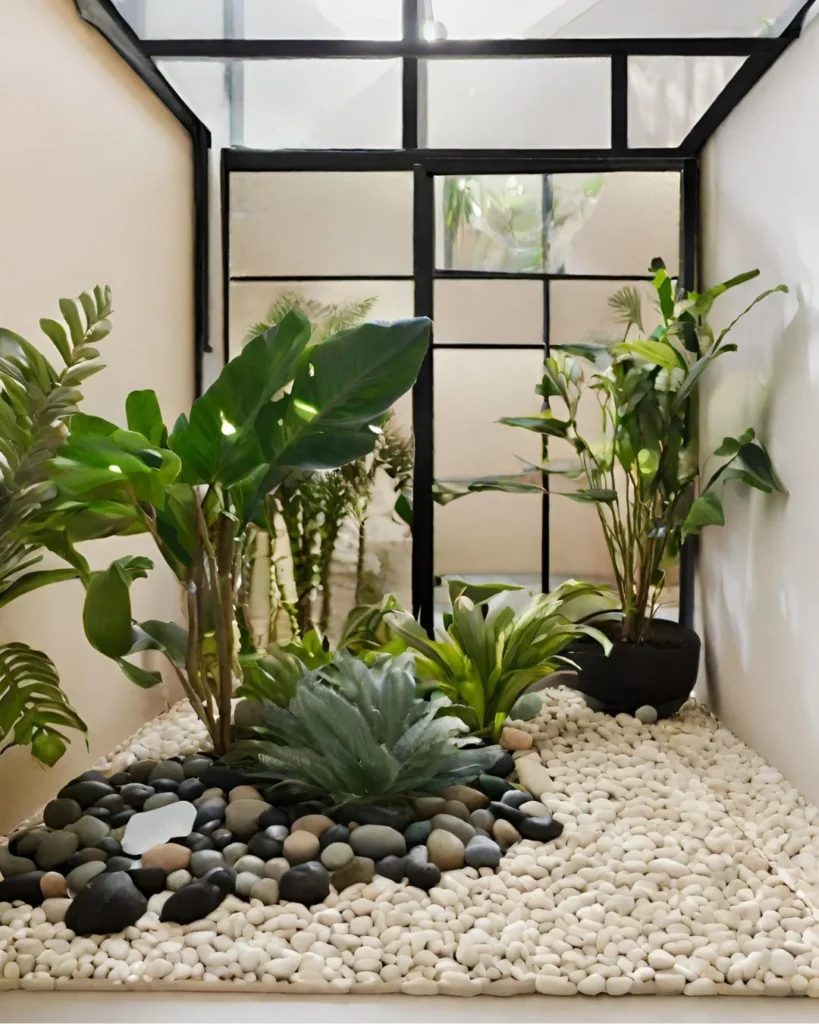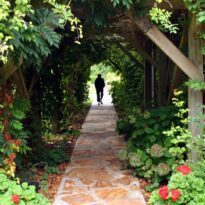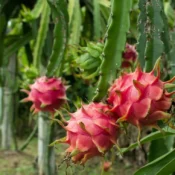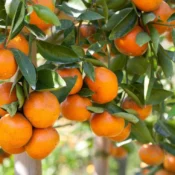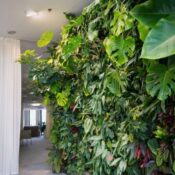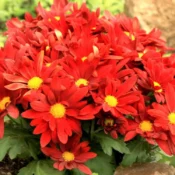A Green Oasis Inside Your Home
Winter gardens, also known as indoor gardens, are spaces where nature seamlessly merges with the indoor environment. They are much more than a decorative room or a hobby. They represent a tangible expression of biophilia – our innate tendency to seek connections with nature and other forms of life. This fascination with indoor gardens reveals a lot about our deep relationship with the natural world.
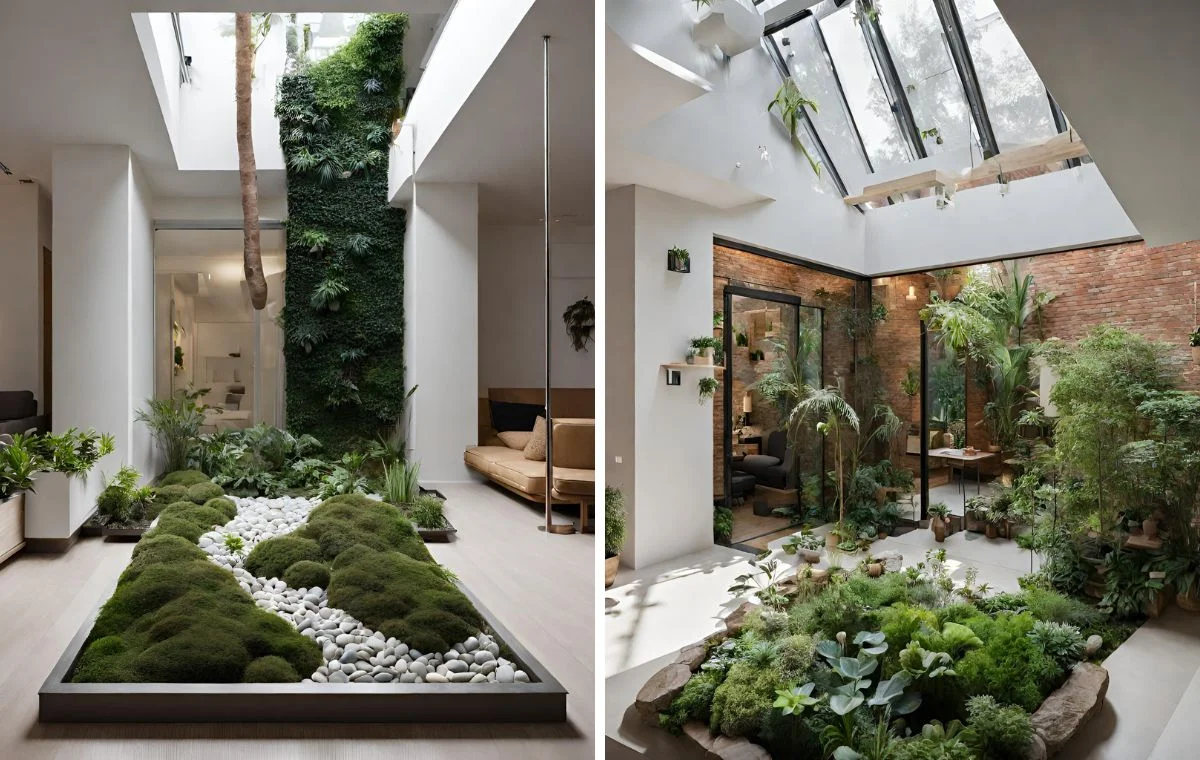
Concept and Function of the Winter Garden
Winter gardens are spaces dedicated to the cultivation of plants inside homes or commercial buildings. Their concept is often confused with that of an indoor garden, and both terms can be used interchangeably. Some prefer to use the term winter garden only for indoor gardens in temperate climates, where enclosed structures with glass are necessary. However, the term has now gained a broader meaning, applicable to atriums and internal patios, whether covered with a skylight or not, as well as other types of indoor gardens. They vary in size and complexity, from small collections of plants in a sunny window to elaborate greenhouses integrated into the building’s architecture. The purpose of these gardens extends beyond beautification; they are designed to create an ideal microclimate for both plants and humans, offering a green sanctuary that rejuvenates, inspires, and connects occupants with nature.
Biophilia
The concept of biophilia, popularized by biologist Edward O. Wilson, suggests that humans have an innate affinity with the natural world. Winter gardens are a physical manifestation of this connection. They not only bring elements of the natural world into our living and working spaces but also offer a complete sensory experience – from the scent of soil and plants to the sight of foliage and flowers.
Benefits
Winter gardens significantly impact the psychological and physical well-being of individuals. They can reduce stress, increase calmness, and promote a state of relaxation. Studies show that the presence of plants and green spaces indoors improves air quality, boosts productivity, and even enhances mood. The visual and physical connection with plants can reduce mental fatigue and increase creativity.
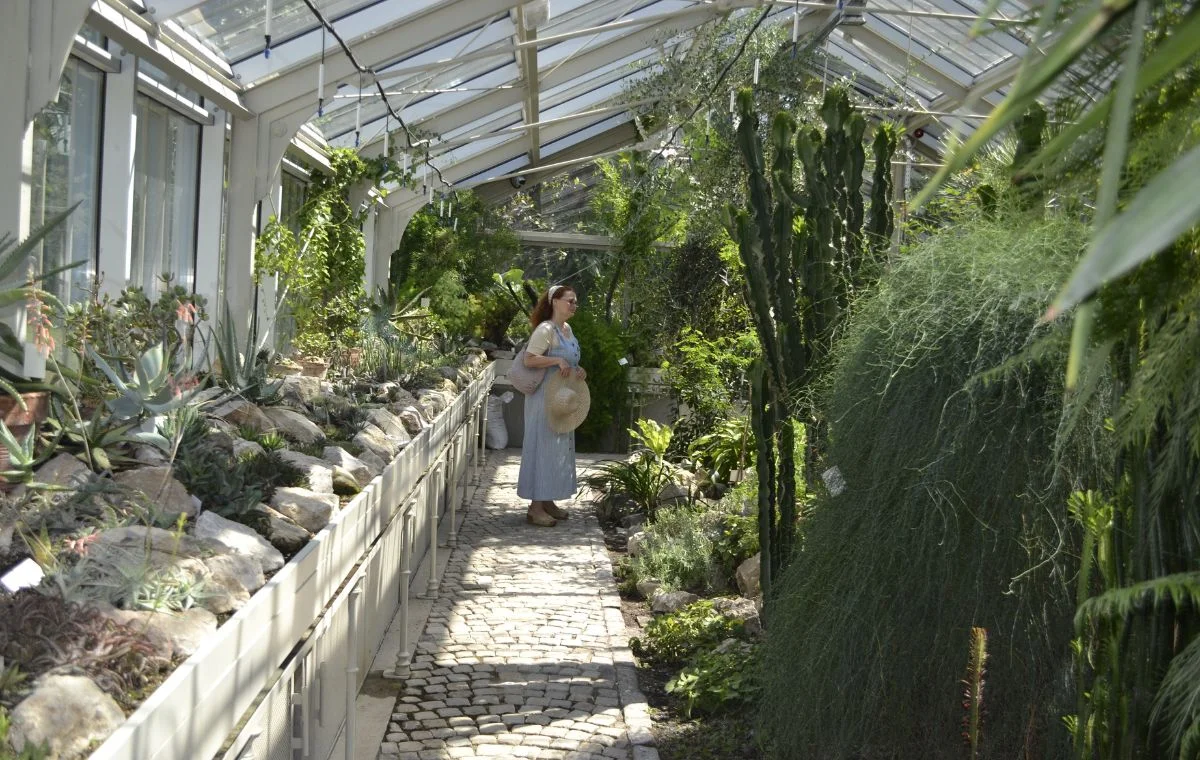
Beyond the health benefits, winter gardens contribute to environmental sustainability. They can assist in regulating indoor temperature, reducing the need for artificial heating and cooling. Plant transpiration helps to humidify the air, creating a more comfortable and healthy environment. Additionally, plants can filter pollutants and improve indoor air quality.
The implementation of winter gardens not only enriches the aesthetics and comfort of the environment but can also significantly increase the property’s value. These indoor green spaces are attractive to buyers and renters, offering a unique differential, combining beauty and functionality.
Historical Origins
The history of indoor gardens dates back to antiquity. In the Roman Empire, atriums were adorned with potted plants hanging, evidence of the aesthetic appreciation of plants in daily life. Romans also built greenhouses with mica blades, using the heat from fermenting manure to force the growth of vegetables and exotic plants collected in tropical regions during their military campaigns.
In the early 17th century in England, “orangeries” emerged, greenhouses intended for the cultivation of citrus trees, like orange, lemon, and tangerine trees, brought from the East, indicating advancement in architecture and interest in botany. George Washington, at his residence in Mt. Vernon, maintained a space dedicated to cultivating exotic plants, demonstrating the popularity of this practice in the United States.
The Influence of Plant Hunters and the Necessary Technologies
The development of indoor gardens owes much to plant hunters, individuals who traveled the world collecting exotic species. After all, to grow species collected in tropical locations, it was necessary to create an appropriate microclimate, protecting the plants from cold, dry air, and other inclemencies uncommon in their habitat.
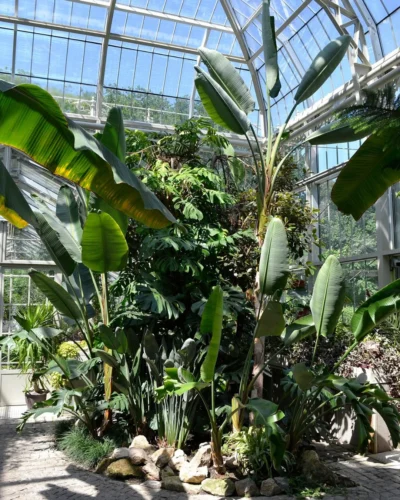
This practice began in Ancient Egypt and continued through the ages, with the armies of Greece and Rome, the Crusaders, and explorers like Columbus, contributing to the diversity of available plants. During the 17th and 18th centuries, it was common for colonial and merchant ships to include a botanist to identify potentially useful plants in the areas to be explored. A notable example is William Dampier, a 17th-century pirate who collected plants in South America and described them in his publications.
And imagine, all these plants could not simply be planted in the garden. Many of them needed a special place, seeking to reproduce the environmental characteristics of the collection sites. People started with internal courtyards, but that was not always enough. Thus, new technologies were needed to support this demand for controlled environments.
Records indicate that glass roofs began to be used in orangeries (greenhouses for orange trees) in England in 1717. This innovation allowed sunlight to enter the greenhouses more effectively, essential for plant growth, culminating in structures like Paxton’s Crystal Palace in 1851. Despite the proliferation of this type of construction, much information about growing exotic plants indoors was still lacking. Publications like “Every Man His Own Gardener” by John Abercrombie and “The Greenhouse Companion” by Claudius Loudon provided detailed instructions for caring for these delicate plants.
In the United Kingdom, the Victorian era marked a period of fervent passion for exotic plants. Cultivating these plants indoors required technical innovations. Heating systems were developed, including holes in the ground where hot coal blocks could be placed and brick flues. In the context of gardening and historical greenhouses, coiled brick flues provided an important method of heating. They allowed the heat generated by a furnace or fireplace to be conducted through the coiled brick flues imbedded in brick walls to other parts of the building or greenhouse, maintaining a warm environment conducive to the growth of plants that required higher temperatures.
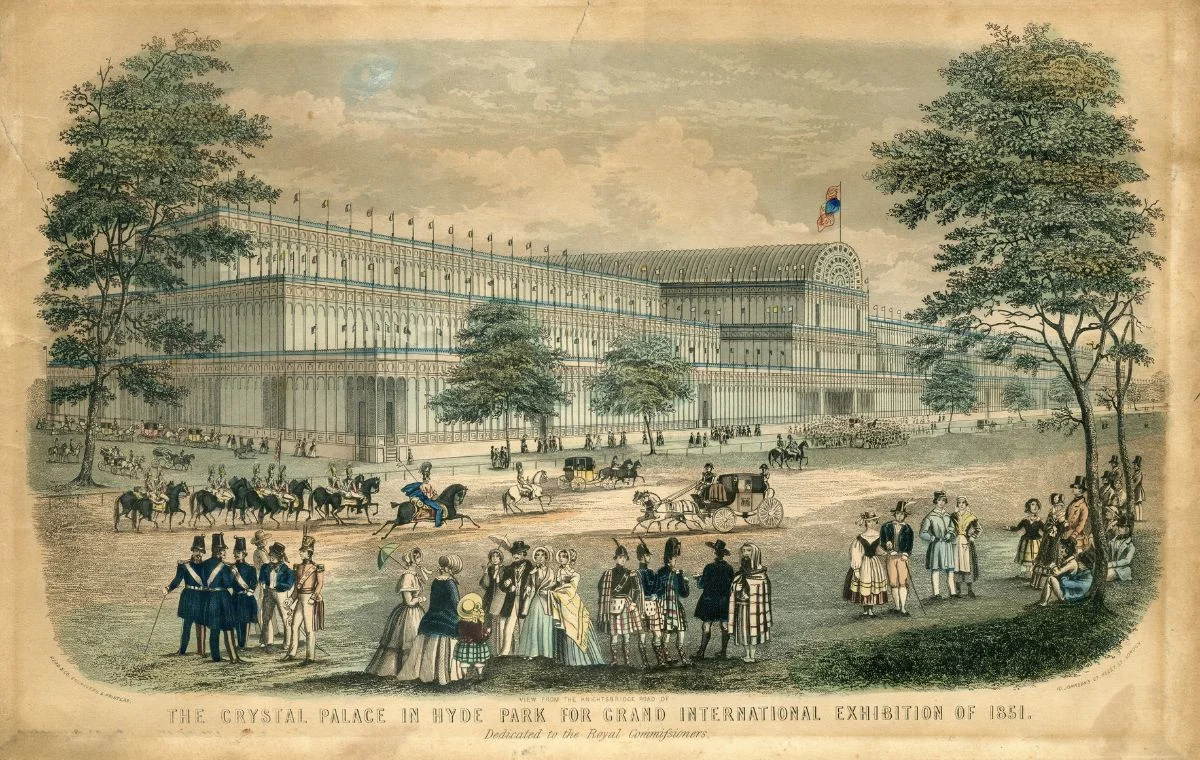
The water heating system emerged in the Netherlands in the early 19th century. It consisted of a network of metal pipes through which water heated by a boiler circulated, usually fueled by wood, coal, or gas. This hot water, flowing through the pipes, released heat in a uniform and controlled manner, creating an ideal environment for the growth of climate-sensitive plants. This system allowed precise temperature control inside greenhouses, facilitating the cultivation of a wider variety of exotic and tropical plants in colder climates, which was a significant advantage over previous heating methods.
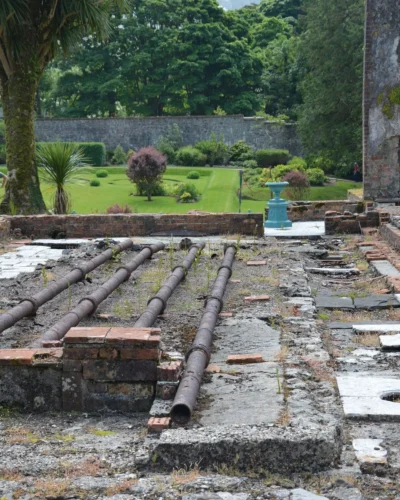
Influenced by European innovations and trends, particularly the growing popularity of indoor gardens in the United Kingdom, American society began adopting houseplants on a larger scale. Large windows and bay windows became popular sites for plant cultivation, not only for practical reasons but also as a statement of elegance and good taste. These plant-filled windows reflected a growing desire to bring nature indoors, a trend that aligned well with the Victorian appreciation of beauty and ornamentation in everyday life.
This interest in houseplants in the United States during the Victorian era can be seen as a precursor to the broader resurgence of indoor gardens in the 20th century. The practice, which started as a necessity among early settlers, transformed into a form of artistic expression and connection with nature within the home, laying the groundwork for future trends in indoor gardening and interior design.
After a brief decline in the early 20th century, there was a global resurgence in interest in houseplants, driven by a renewed appreciation for nature and the aesthetic and psychological benefits of plants. Contemporary design began to integrate indoor gardens as essential elements, reflecting a fusion between nature and architecture. Scandinavia, known for its minimalist design and emphasis on nature, embraced and expanded this trend, creatively integrating gardens into indoor spaces as part of their design approach, thus gaining significant architectural prominence and becoming a reference in winter gardens.
Indoor Gardens Today
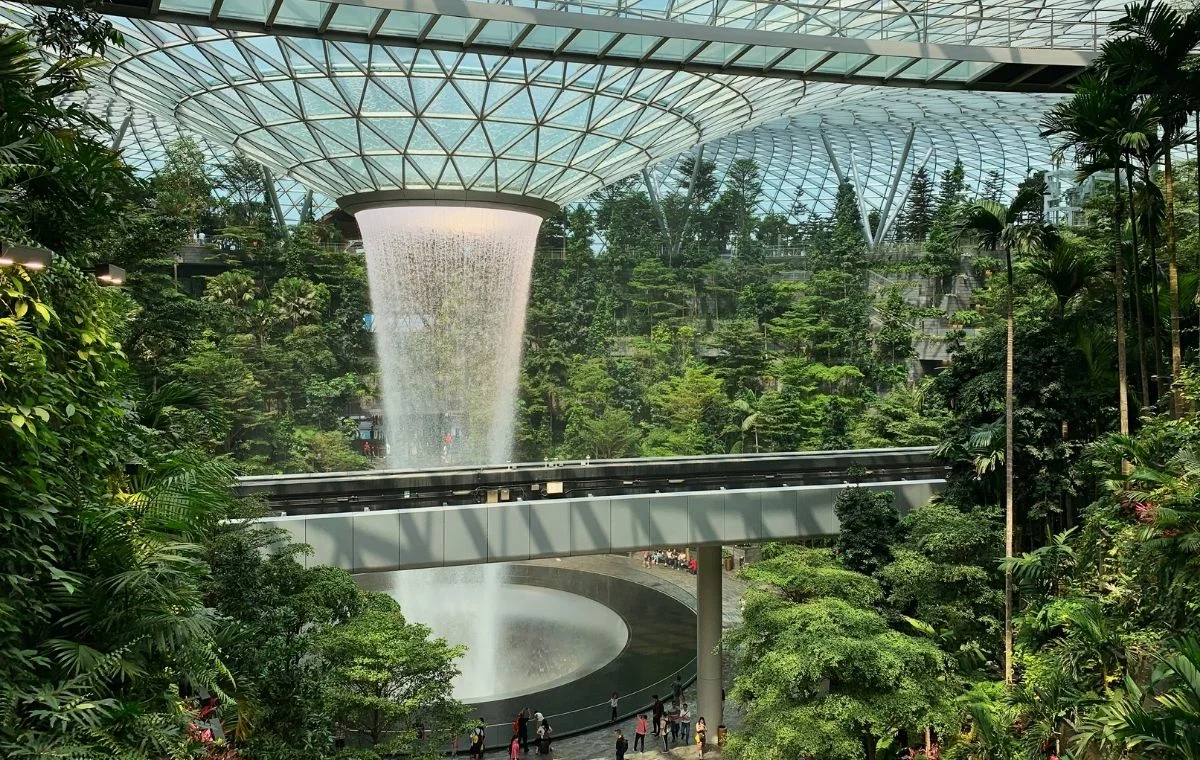
Indoor gardens are gaining popularity, especially among younger home buyers. This phenomenon, largely driven by a younger and environmentally conscious audience, points to an evolution in the way people interact with their spaces. This aligns with growing environmental awareness and a desire for a touch of nature in indoor environments.
The pandemic accelerated this process, as people needed to stay at home, often deprived of contact with nature. One of the preferred locations for creating winter gardens is in those spaces, often forgotten and unused, under stairs. Thus, stairs, often seen merely as transitional spaces, are being reinvented as vibrant and lively places, thanks to the addition of plants.
Indoor Gardens in the United States
In the United States, the concept of indoor gardens has evolved from the early settlers to modern times, focusing on integrating plants into residential and commercial spaces. This trend is marked by the use of diverse plant species, ranging from exotic orchids to native ferns like the Boston Fern (Nephrolepis exaltata). In urban settings, easy-to-care-for plants like the Snake Plant (Sansevieria trifasciata) are popular for their air-purifying qualities and adaptability to indoor environments.
Indoor Gardens in the United Kingdom
The tradition of indoor gardens in the United Kingdom, rooted in the 17th-century orangeries, continues today with a mix of traditional and exotic plants. English Ivy (Hedera helix), known for its lush, trailing vines, is commonly found alongside more exotic species like the African Violet (Saintpaulia). These gardens often blend the elegance of classic English gardening with the allure of global botany.
Indoor Gardens in Australia
Australian indoor gardens often focus on native species that adapt well to indoor conditions, reflecting the country’s unique biodiversity. Plants like the Kangaroo Paw Fern (Microsorum diversifolium) and the Australian Sword Fern (Nephrolepis obliterata) are popular for their resilience and distinct appearance. Additionally, the trend of vertical gardens includes species like the Bird’s Nest Fern (Asplenium nidus), which thrives in Australian indoor conditions.
Indoor Gardens in Canada
In Canada, indoor gardens serve as green oases during long winters, featuring both ornamental and functional plants. The Peace Lily (Spathiphyllum) is favored for its ability to thrive in lower light conditions, making it ideal for Canadian homes. Canadians also embrace edible plants in their indoor gardens, with herbs like Basil (Ocimum basilicum) and vegetables such as Cherry Tomatoes (Solanum lycopersicum var. cerasiforme) being common choices.
Indoor Gardens in New Zealand
New Zealand’s indoor gardens reflect the country’s deep connection to its unique natural landscape, incorporating indigenous elements and native species. The Silver Fern (Cyathea dealbata), an iconic symbol of New Zealand, is a popular choice, alongside other native plants like the Pohutukawa (Metrosideros excelsa), which are adapted for indoor growth. These gardens not only provide a connection to nature but also showcase New Zealand’s commitment to environmental conservation and biodiversity.
Indoor Gardens in South America
In South America, winter gardens have been masterfully adapted to reflect both the region’s rich biodiversity and its distinctive architectural traditions. Characterized by a fusion of indoor and outdoor spaces, these gardens often incorporate open elements, such as internal courtyards and large windows, allowing constant interaction with the local climate and nature. The trend in countries like Brazil, Argentina, and Colombia is towards green spaces that not only beautify the interior but also create a pleasant and healthy microclimate within homes and buildings.
Popular plants in South American winter gardens include native species like the Bromelia and Orchidaceae, which adapt well to indoor environments and add an exotic touch. Others, such as Ficus lyrata and Anthurium, are also favorites for their resilience and ability to improve air quality. These gardens are not only a haven of tranquility but also a showcase of the region’s rich flora.
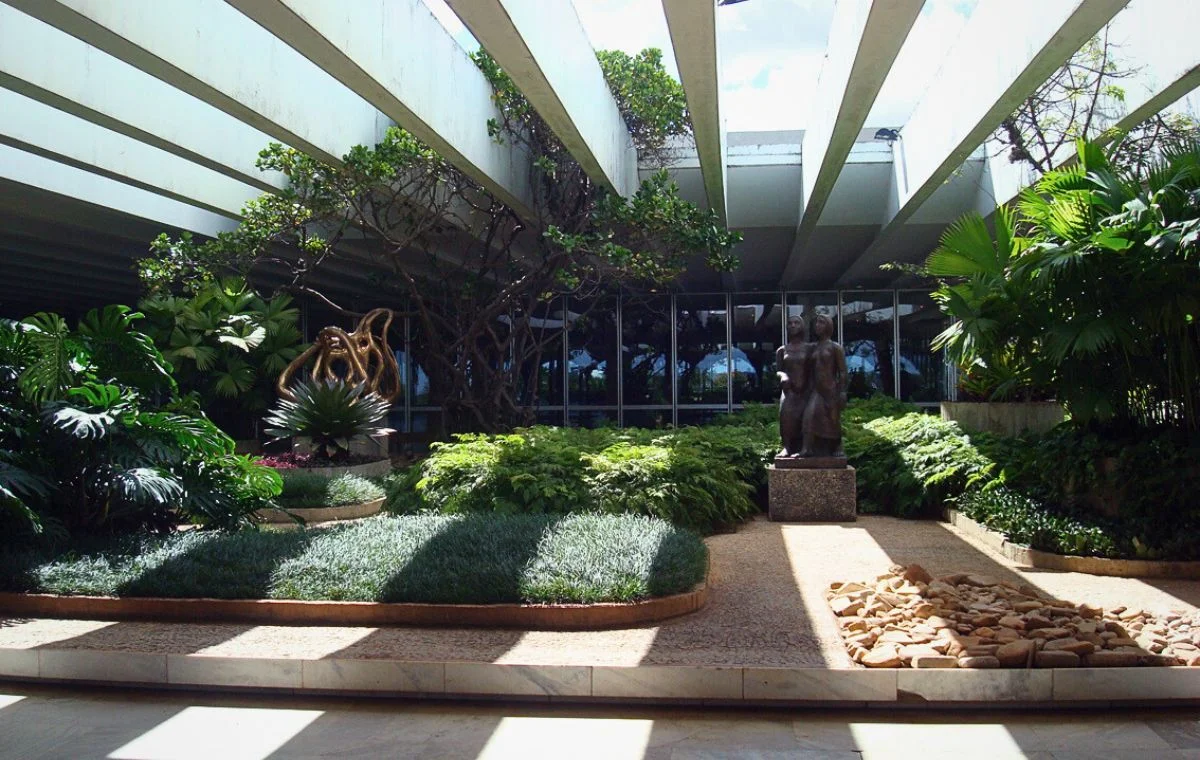
In Brazil, the practice of indoor gardens is influenced by the rich biodiversity and tropical climate. Obviously, the initial goal of providing a modified microclimate for plants is not always necessary. With its continental dimensions, Brazil has subtropical and high-altitude tropical regions that sometimes compel determined gardeners to build greenhouses and indoor gardens to protect special plants from the cold and frost. However, it seems that winter gardens in the country have taken on a form of expression of the biophilic need for contact with nature, and all the decorative appeal this type of garden brings to buildings, regardless of whether the garden is built in equatorial Manaus or in subtropical south of the country.
Residential and commercial spaces often integrate native and exotic plants, creating a vibrant environment that reflects the exuberance of Brazilian flora. Species of philodendrons and bromeliads are common, as well as the use of ferns and orchids. Brazilian architecture, notably influenced by figures like Oscar Niemeyer, often incorporates indoor gardens as central elements of design, seeking harmony between the built and natural environments.
Future Perspectives
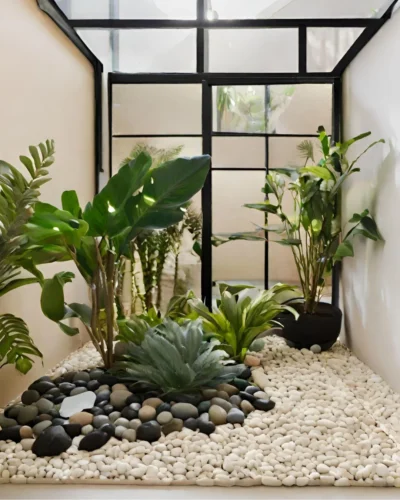
In an era where we spend most of our time indoors, winter gardens offer an increasingly vital window to the beauty and tranquility of the garden, aligning perfectly with the concept of biophilia and the human desire to integrate nature into all aspects of life.
The trend of gardens in stairs may expand to other architectural elements, incorporating greenery in increasingly creative and sustainable ways. We can already envision glass-enclosed and planted balconies extending into living rooms, with a large integrated garden. Bland corridors are being transformed into beautiful green walls. While winter gardens used to occupy functionless spaces, today they are often considered already in the design phase.
Companies specializing in the design and implementation of this type of garden are emerging, as well as the development of automated plant care systems, optimizing the maintenance of winter gardens. Moreover, in urban areas with limited space, such as apartments and residences, winter gardens can become even more compact and efficient, using innovative solutions to maximize these areas.
Design and Architectural Integration of the Indoor Garden
A well-designed winter garden should be integrated into people’s daily routine, located in a space that promotes constant interaction with the plants. The design should consider the client’s desire and ability to care for the plants, the type of location, the function and design of the building, and the budget. The lighting system is crucial, especially in areas with limited natural light. Let’s explore the main characteristics of winter gardens:
1. Location
- Architectural Integration: Winter gardens are often integrated into the architecture of the building, located in areas such as living rooms, hallways, or even under stairs. In some cases, they are built as glass extensions of houses.
- Exposure to Light: Natural light is a crucial aspect. Ideally, they are positioned to maximize sunlight exposure, often through glass walls, skylights, or large windows.
- Access and Visibility: They are designed to be easily accessible and visible, providing a constant experience with nature for the inhabitants of the house.
2. Plant Selection
- Variety: The choice of plants depends on the climate, lighting, and moisture conditions of the garden. Tropical plants, succulents, ferns, orchids, and ground covers are common options. However, the selection can also consider useful aspects, such as the use of vegetables, herbs, and medicinal plants.
- Adaptation to Indoor Environment: Plants should be selected based on their ability to thrive in indoor conditions, taking into account factors such as temperature, light, ventilation, and relative humidity.
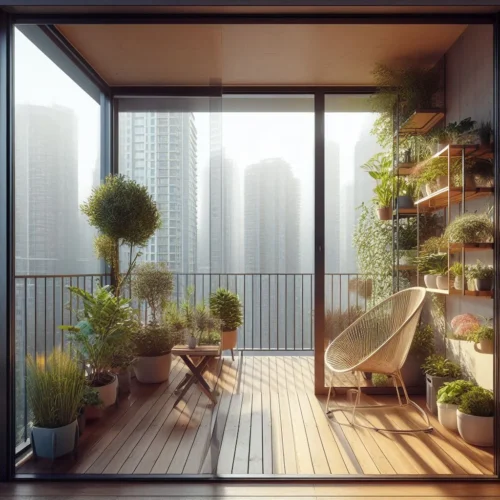
3. Maintenance
- Irrigation: Irrigation systems can range from simple manual watering to automatic irrigation systems, depending on the size and complexity of the garden.
- Climate Control: In some cases, it may be necessary to control temperature and humidity, especially for tropical plants in colder climates.
- Pruning and Care: Regular maintenance, including pruning, fertilization, and pest control, is essential to keep the plants healthy and the garden aesthetically pleasing.
4. Aesthetic Aspects
- Design and Decoration: The design of the winter garden can range from minimalist and modern to lush and tropical. Decorative elements such as rocks, waterfalls, sculptures, and garden furniture are often used.
- Integration with Indoor Space: The garden’s design should harmonize with the home’s interior decor, creating a seamless flow between indoors and the garden.
Indoor gardens are a charming fusion of functionality and aesthetics, offering a green haven within residential or commercial spaces. They not only enrich the environment with natural beauty but also promote a healthier and more sustainable lifestyle. The key to a successful winter garden lies in the harmony between the plants’ needs and the inhabitants’ lifestyle, creating a space that is both revitalizing and reassuring.

